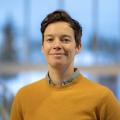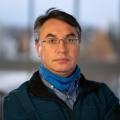The goal of cryospheric research at the Geophysical Institute is to understand the properties and processes that occur within snow, ice and permafrost, their role in the shaping of the landscape, and their influence on climate and impact on the biosphere. Studies include field investigations throughout the Arctic, Antarctic, and mountainous regions of our planet.
Research Areas
The Arctic Beaver Observation Network (A-BON) is a group of scientists, indigenous groups, land managers, and local observers who are concerned about the expansion of beaver populations into Arctic landscapes. This collaboration began in 2020 and assembles a broad range of perspectives from Alaska, Canada, and Europe to coordinate research and observations related to beaver colonization of the Arctic and the impacts it is having on ecosystems and people.
Arctic Beaver Observation Network
Contact: Ken Tape
Our research consists of a wide range of topics, including glacier mass-balance and volume change studies using e.g. repeat-profile airborne laser altimetry, the dynamics of lake and tidewater calving glaciers, ice sheet modeling, and glacier seismicity. Methods encompass modeling, remote sensing and field observations. Current field sites include Greenland, Antarctica and various sites in Alaska.
Our group
- organizes the biennial International Summer School in Glaciology
- develops the Parallel Ice Sheet Model (PISM)

Contact: Andy Aschwanden, Mark Fahnestock, Martin Truffer
The buoyancy of ice is such a well known phenomenon that it is easy to forget its importance. The world would be a vastly different place if ice sunk to the bottom of the sea, where it would accumulate and fill the ocean basins. In our floating ice world however, the ice remains on the surface where it modulates the global climate by reflecting solar energy and insulating the waters beneath. It also provides a habitat and platform for a wide range of organisms and is utilized as a travel corridor by man as well.
Contact: Andrew Mahoney
The focus of our research is the development of methods to physically and mathematically model permafrost interactions with the climate system (permafrost modeling), the study of naturally and human induced disturbances of permafrost (permafrost process studies), the detection of changes in permafrost temperature, thickness, and distribution over time (permafrost monitoring), and the prediction of impacts of permafrost changes on the natural environment (e.g. ecosystems, hydrology, carbon cycle) as well as human-related concerns (e.g. infrastructure). We are interested in all aspects of how permafrost is affected by global change with respect to climate as well as natural and human induced disturbances.
Contact: Louise Farquharson, Dmitry Nicolsky, Alexander Kholodov
With its long winters and cold temperatures, Alaska is a natural laboratory for understanding snow processes. The Geophysical Institute’s Snow, Ice, and Permafrost (SIP) group begins with "S" because snow plays a key role in the evolution of permafrost, the growth of glaciers, and the seasonal transformation of sea ice.
At the Geophysical Institute, we study how snow impacts the people, weather, and climate of the Arctic and subarctic. Our projects study the snow-landscape interaction at scales ranging from meters to thousands of kilometers. We use many tools to measure snow properties in situ, from automatic snow depth probes to snow density cutters and Federal snow sampling tubes. We remotely sense snow over tundra and sea ice from drones and radar. Low-earth orbit satellite remote-sensing products are also vital to our studies.
Our team engages people of all ages in exploring snow's beauty, wonder, and cultural aspects through digital outreach, classroom visits, and museum exhibits.
Contacts: Jennifer Delamere, Matthew Sturm
Project Highlights
Our Winter World
Our Winter World aims to engage people of all ages in exploring the beauty, wonder, science, and cultural aspects of snow through in-person and digital outreach, museum exhibits, and exchange of traditional and western scientific knowledge about snow. Our Winter World is a partnership of the University of Alaska Fairbanks' Geophysical Institute, the Oregon Museum of Science and Industry, the Center of Science and Industry, and the Goldstream Group.
Funding for Our Winter World has been provided by the National Science Foundation.
Parallel Ice Sheet Model
The Parallel Ice Sheet Model (PISM) is an open-source modelling framework for ice sheets and glaciers. It is parallel, thermodynamically-coupled and capable of high resolution. PISM has been widely adopted as a tool for doing science for about twenty years now.
PISM is jointly developed at the University of Alaska, Fairbanks (UAF) and the Potsdam Institute for Climate Impact Research (PIK). UAF developers are based in the Glaciers Group at the UAF Geophysical Institute. For more about the team see the developers team page.
Development of PISM is supported by NASA grants 20-CRYO2020-0052 and 80NSSC22K0274 and NSF grant OAC-2118285.
Trafficability of Landfast Sea Ice
Traveling over sea ice is heavily affected by the snow cover. As part of the Integrated System for Operations in Polar Seas ISOPS project, we investigate the trafficability of landfast sea ice. We use satellite and drone-based sea ice observations to investigate how surface roughness affects travel. We also study how snow deposition and redistribution smooth or roughen the ice surface, making traveling faster or slower.
Contacts: Anika Pizner, Achille Capelli, Andy Mahoney
International Summer School in Glaciology
The University of Alaska Fairbanks (UAF) has organized biennial summer schools in glaciology since 2010 open to graduate students in glaciology around the world. The course is held at the Wrangell Mountains Center in McCarthy, Alaska.
- 7-17 June 2024
We received 121 applications for the available 28 slots.
Lecturers
Andy Aschwanden (Univ. of Alaska Fairbanks, UAF), Ed Bueler (UAF), Mark Fahnestock, (UAF), Regine Hock (UAF/Oslo Univ.), Martin Truffer (UAF); Karen Alley (University of Manitoba, Canada), Gwenn Flowers (Simon Fraser University, Canada), David Rounce (Carnegie Mellon Univ.); Guest lecturer: Mike Loso (National Park Service).























